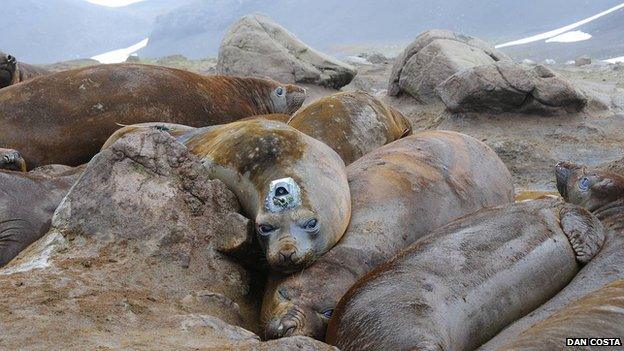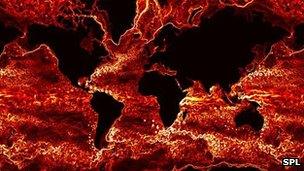'Mobile marine reserves' needed
- Published

Tags on an elephant seal will record details of temperature, depth and the salinity of the water
Mobile marine reserves are needed to protect ocean species, say scientists.
The idea that only fixed areas of ocean can be designated as no-catch zones is out-dated, and does not reflect the very dynamic behaviour of some ocean creatures, they argue.
The marine experts made their call at the AAAS meeting, external - a major American science festival in Vancouver, Canada.
They say the huge volumes of data from animal tracking studies demand new approaches to conservation in our seas.
"Less than 1% of the ocean is protected at this point, and these marine parks tend to be built around things that sit still like coral reefs and seamounts," explained Prof Larry Crowder from Stanford University.
Prof Larry Crowder from Stanford University: "Many organisms... respond to oceanographic features that don't have a fixed point"
"But tracking studies show that many, many organisms - fish, marine mammals, sea turtles, seabirds and sharks - respond to oceanographic features that don't have a fixed point.
"These features are fronts and eddies that may move seasonally, from summer to winter, and from year to year based on oceanographic climate changes like El Nino or the Pacific Decadal Oscillation."
The challenge now, argue Crowder and other marine scientists, is to try to build a system of marine reserves that are as dynamic as the creatures they trying to protect.
Game of tags
The spur for this new thinking is the avalanche of data coming from tagging projects.
All manner of creatures are being tracked over vast distances, using increasingly sophisticated devices.
Many of the innovations that have improved the performance and functionality of mobile phones are being incorporated into the latest generation of tags.

Currents and long-term climatic shifts change where water - and its inhabitants - go
These devices not only record where the animals go, but they also return information about the ocean state.
"We can now put multiple sensors in a single tag and when you boost the battery with something like a solar assist panel, you just get this incredible opportunity to view what an animal is doing in multiple dimensions and for long periods of time," said Dr Kristin Hart, a research ecologist with the US Geological Survey, who showed the meeting some of tiniest tags now in operation.
"Size is important, particularly when you want to answer questions about juveniles or really fast-moving individuals such as tuna - you do not want to encumber the animal with something big and clunky or you will affect its behaviour."
Research has shown how species will respond to upwellings, fronts and eddies in the water, and how creatures will chase the nutrients and the food webs built in these oceanic features. Critically, though, these features may come and go, or shift their position.
Dr Kristin Hart, a research ecologist, spoke about the tiny tags
Future marine reserves will need to reflect this dynamism, says Prof Crowder.
Implementing Marine Protected Areas has proved something of a struggle for conservationists, and some interests may baulk at the idea of reserves being defined by anything other than co-ordinates on a sea chart.
Prof Crowder is convinced the concept he and his peers are proposing is realistic, however.
"In addition to knowing where the animals are and how they respond to ocean features, we also know a lot more about where the fishermen are. The fishermen have very precise GPS. So I don't think it's outside the realm of possibility to get fishermen to observe where the edge of a mobile reserve is."
Jonathan.Amos-INTERNET@bbc.co.uk and follow me on Twitter, external